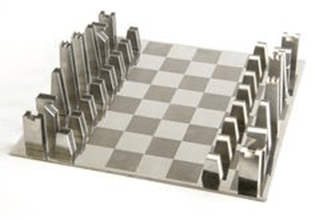- Jacksons appoint Basil Goldswain
- New Combination Handwash Urinal
- Stainless Steel Roofing in Four Mining Applications
- Development Initiative
- Know Your hfa Fabricator ALBERT MOORE (Pty) Ltd
- 2 New Directors for Jacksons Johannesburg
- Nuclear Power Station
- The Automobile and Stainless Steel
- Check! With Stainless Steel
- A Guide to Stainless Steel
- Buyers’ Guide Now Available
- Stainless Steel Label
- Editorial Comment – We Introduce Ourselves
- Editorial Comment
- Gordon Ricketts Retires from S.A.S.S.D.A.
- Stainless Steel Jottings
- Atlas Steels pour metal into first curved slab continuous casting machine
- Cape firm pioneers bulk milk cooling tanks in Stainless Steel
- Company Run Like A Swiss Watch
 STAINLESS STEEL has come to the aid of a South African designer, Mr. Peter Davis, who was faced with a thousand-year-old problem and while it is not claimed that it has solved it, the answer is certainly unique and attractive. It is a stainless steel chess set of a completely new design with two types of finish to distinguish the two sides.
STAINLESS STEEL has come to the aid of a South African designer, Mr. Peter Davis, who was faced with a thousand-year-old problem and while it is not claimed that it has solved it, the answer is certainly unique and attractive. It is a stainless steel chess set of a completely new design with two types of finish to distinguish the two sides.
Ever since the intriguing and fascinating game of chess was invented, more than a thousand years ago, it has offered a challenge to designers who have sought the perfect set which would express a harmonious whole and at the same time indicate the weight and power of each of the six separate pieces.
In choosing a material for his computer set, Mr. Davis selected stainless steel which he felt represented strength and beauty as well as adding a modern touch. The name, too, has modern as well as ancient associations because computers have existed in one form or another – such as the abacus – since man first started calculating but have come into their own with the twentieth century.
Describing his new chess set, Mr. Davis says of it: “A pawn normally moves one square at a time and therefore has been made as simple as possible. He stands square on his square and moves one square at a time. A knight’s move is a diagonal of about thirty degrees, two squares in one direction and one square to the side. He has been made, therefore, with his most prominent angle thirty degrees in one direction and has the appearance of a knight in armour with visor raised. The knight stands diagonally on his square facing his opposition and presenting a sharp and threatening appearance.
“This bishop moves on diagonals of forty-five degrees and is cut to show this. He stands diagonally on his square in order to have one face turned to each direction in which he may be required to move. He has more ‘weight’ than his knight to show his greater theoretical power and value and has the appearance of a bishop’s mitre.
“The castle moves parallel to the sides of the board, and so it stands square on its square with its sides showing its lines of movement. Its battlements have been shown by a series of small cuts to indicate crenellations, and its size has been determined by its greater theoretical value than the preceding pieces.
“The Queen’s moves combine those of the bishop and the castle, and she is, next to the king, the most valuable piece. She has slimness and strength; she stands square on her square but her delicately-cut crown shows her diagonal powers.
“The king’s move is one square at a time in any direction and he is the most important man on the board.”

